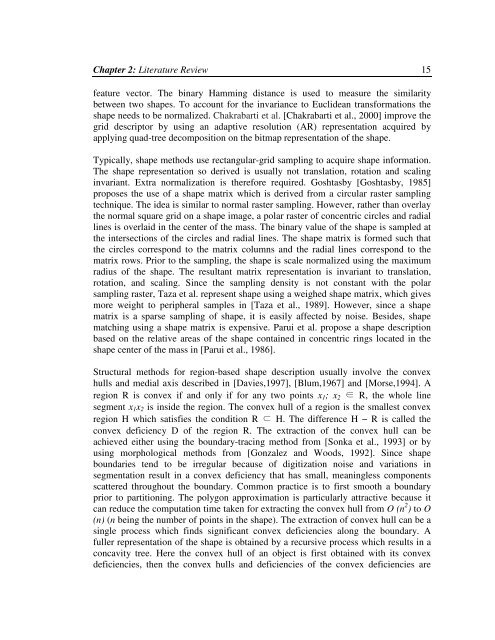To the Graduate Council: I am submitting herewith a thesis written by ...
To the Graduate Council: I am submitting herewith a thesis written by ...
To the Graduate Council: I am submitting herewith a thesis written by ...
Create successful ePaper yourself
Turn your PDF publications into a flip-book with our unique Google optimized e-Paper software.
Chapter 2: Literature Review 15feature vector. The binary H<strong>am</strong>ming distance is used to measure <strong>the</strong> similaritybetween two shapes. <strong>To</strong> account for <strong>the</strong> invariance to Euclidean transformations <strong>the</strong>shape needs to be normalized. Chakrabarti et al. [Chakrabarti et al., 2000] improve <strong>the</strong>grid descriptor <strong>by</strong> using an adaptive resolution (AR) representation acquired <strong>by</strong>applying quad-tree decomposition on <strong>the</strong> bitmap representation of <strong>the</strong> shape.Typically, shape methods use rectangular-grid s<strong>am</strong>pling to acquire shape information.The shape representation so derived is usually not translation, rotation and scalinginvariant. Extra normalization is <strong>the</strong>refore required. Goshtas<strong>by</strong> [Goshtas<strong>by</strong>, 1985]proposes <strong>the</strong> use of a shape matrix which is derived from a circular raster s<strong>am</strong>plingtechnique. The idea is similar to normal raster s<strong>am</strong>pling. However, ra<strong>the</strong>r than overlay<strong>the</strong> normal square grid on a shape image, a polar raster of concentric circles and radiallines is overlaid in <strong>the</strong> center of <strong>the</strong> mass. The binary value of <strong>the</strong> shape is s<strong>am</strong>pled at<strong>the</strong> intersections of <strong>the</strong> circles and radial lines. The shape matrix is formed such that<strong>the</strong> circles correspond to <strong>the</strong> matrix columns and <strong>the</strong> radial lines correspond to <strong>the</strong>matrix rows. Prior to <strong>the</strong> s<strong>am</strong>pling, <strong>the</strong> shape is scale normalized using <strong>the</strong> maximumradius of <strong>the</strong> shape. The resultant matrix representation is invariant to translation,rotation, and scaling. Since <strong>the</strong> s<strong>am</strong>pling density is not constant with <strong>the</strong> polars<strong>am</strong>pling raster, Taza et al. represent shape using a weighed shape matrix, which givesmore weight to peripheral s<strong>am</strong>ples in [Taza et al., 1989]. However, since a shapematrix is a sparse s<strong>am</strong>pling of shape, it is easily affected <strong>by</strong> noise. Besides, shapematching using a shape matrix is expensive. Parui et al. propose a shape descriptionbased on <strong>the</strong> relative areas of <strong>the</strong> shape contained in concentric rings located in <strong>the</strong>shape center of <strong>the</strong> mass in [Parui et al., 1986].Structural methods for region-based shape description usually involve <strong>the</strong> convexhulls and medial axis described in [Davies,1997], [Blum,1967] and [Morse,1994]. Aregion R is convex if and only if for any two points x 1 ; x 2 R, <strong>the</strong> whole linesegment x 1 x 2 is inside <strong>the</strong> region. The convex hull of a region is <strong>the</strong> smallest convexregion H which satisfies <strong>the</strong> condition R H. The difference H − R is called <strong>the</strong>convex deficiency D of <strong>the</strong> region R. The extraction of <strong>the</strong> convex hull can beachieved ei<strong>the</strong>r using <strong>the</strong> boundary-tracing method from [Sonka et al., 1993] or <strong>by</strong>using morphological methods from [Gonzalez and Woods, 1992]. Since shapeboundaries tend to be irregular because of digitization noise and variations insegmentation result in a convex deficiency that has small, meaningless componentsscattered throughout <strong>the</strong> boundary. Common practice is to first smooth a boundaryprior to partitioning. The polygon approximation is particularly attractive because itcan reduce <strong>the</strong> computation time taken for extracting <strong>the</strong> convex hull from O (n 2 ) to O(n) (n being <strong>the</strong> number of points in <strong>the</strong> shape). The extraction of convex hull can be asingle process which finds significant convex deficiencies along <strong>the</strong> boundary. Afuller representation of <strong>the</strong> shape is obtained <strong>by</strong> a recursive process which results in aconcavity tree. Here <strong>the</strong> convex hull of an object is first obtained with its convexdeficiencies, <strong>the</strong>n <strong>the</strong> convex hulls and deficiencies of <strong>the</strong> convex deficiencies are
















